话语标记语论文:话语标记语wellsolike及youknou中国英语专业研究生语境语用功能
话语标记语well关联顺应性论文
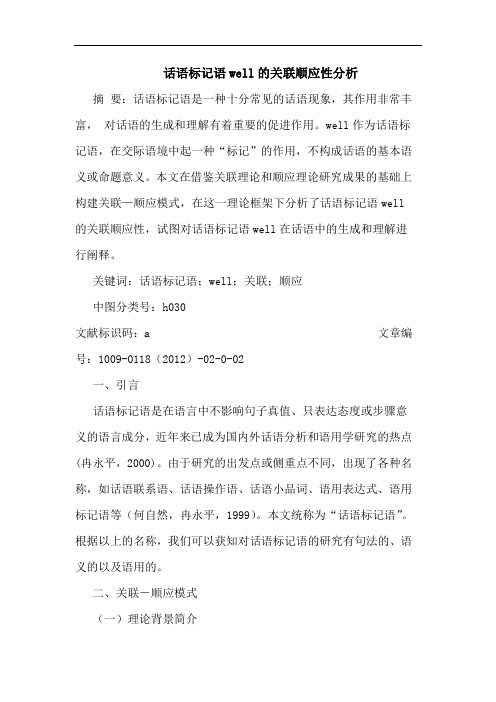
话语标记语well的关联顺应性分析摘要:话语标记语是一种十分常见的话语现象,其作用非常丰富,对话语的生成和理解有着重要的促进作用。
well作为话语标记语,在交际语境中起一种“标记”的作用,不构成话语的基本语义或命题意义。
本文在借鉴关联理论和顺应理论研究成果的基础上构建关联—顺应模式,在这一理论框架下分析了话语标记语well的关联顺应性,试图对话语标记语well在话语中的生成和理解进行阐释。
关键词:话语标记语;well;关联;顺应中图分类号:h030 文献标识码:a 文章编号:1009-0118(2012)-02-0-02一、引言话语标记语是在语言中不影响句子真值、只表达态度或步骤意义的语言成分,近年来已成为国内外话语分析和语用学研究的热点(冉永平,2000)。
由于研究的出发点或侧重点不同,出现了各种名称,如话语联系语、话语操作语、话语小品词、语用表达式、语用标记语等(何自然,冉永平,1999)。
本文统称为“话语标记语”。
根据以上的名称,我们可以获知对话语标记语的研究有句法的、语义的以及语用的。
二、关联-顺应模式(一)理论背景简介1、关联理论sperber和wilson(1986/1995)认为:交际活动是人类认知活动的一种,交际的基础就是话语的关联性。
sperber和wilson把关联定义为:假设同一系列语境之间的关系,即会话过程中的后一话语与前一话语以及会话赖以存在的语境在语义和语用方面的关系。
在言语交际中,听话人对世界的假设是以概念表征的形式储存于大脑中,构成了用来处理新信息的认知语境(苗兴伟,1997)。
它由三方面的信息组成:逻辑信息、百科信息和词汇信息(何自然,冉永平,1998)。
关联理论结合了另外两种交际模式——语码模式和推理模式,提出了交际中的明示-推理模式。
这种明示-推理过程之所以存在,是因为存在关联原则和最佳关联假设。
关联理论的交际观、认知观,以及它关于最大关联和最佳关联性的理念,对于话语含义的理解有着指导性的意义。
国内英语专业研究生话语标记语习得实证研究——以Well
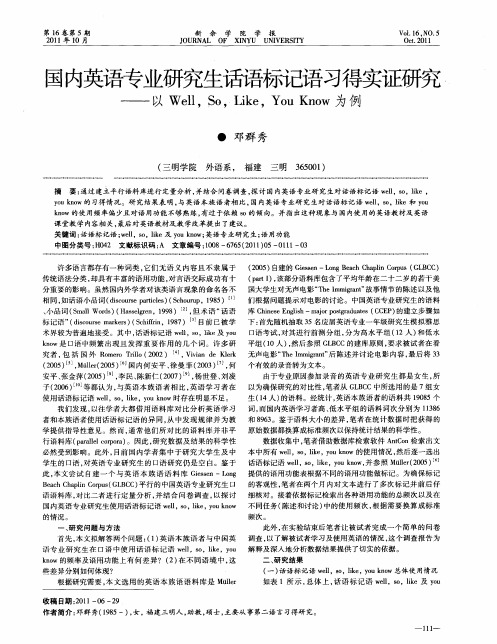
prI , t 传统语法分类 , 却具有丰富的语用功能 , 对言语交际成 功有十 (a )该 部分 语料 库包 含了平均年龄 在二十二岁 的若干美
分重要的影响 。虽然 国内外 学者对该 类语言现象 的命 名各不 国大学 生对 无声 电影 “ h m gat故事情节 的陈述以及他 T eI ir ” m n
必然受到影 响。此外 , 目前 国 内学 者集 中于研 究大 学生 及 中 本 中所有 w l O l e yuk o el ,i , o nw的使用情况 , ,S k 然后逐一选 出 el S,l ,yuk o , k l r2 0 ) l 学生 的 口语 , 对英语专业 研究 生 的 口语研 究仍 是空 白。鉴 于 话 语标记语 w l, O ie o n w 并参 照 Mi e(0 5 此, 本文尝试 自建一 个 与 英语 本 族 语 语料 库 Gesn—L n 提 供的语用功能表根据不同的语用功能做标记。为确保标记 i e s og 笔者在 两个 月 内对 文本进行 了多次标 记并 前后仔 B ahC a l o u( L C ) 行的 中国英语专业研 究生 口 ec hpi C r s G B C 平 n p 的客观性 , 细核对 。接着依据标记检索出各种语用功能的总频次以及在 语语料库 , 比二者进行 定量 分析 , 对 并结合 问 卷调查 , 以探讨
标记语 ” dso r res ( cir ,1 8 ) ( i us makr) Shfi 9 7 c e fn
对其进行前测 分组 , 为高水 平组 ( 2人 ) 分 1 和低水 术界较为普遍 地接 受。其中 , 话语标记语 w l S , i e , O l e及 yu 口语考试 , l k o
第l 6卷第 5期
21 年 1 01 0月
话语标记语well的语用功能分析 词汇学课程论文

英语词汇学课程论文院系外国语学院专业英语师范班级2014级英语师范1班学生姓名陈雪姣学号201410014131任课教师肖祎2016年 12月 22日Pragmatic Analysis of the Discourse Marker Well 2014级英语师范专业学生:陈雪姣学号:201410014131Abstract: This paper focuses on the pragmatic functions of the discoursemarker well in verbal interaction.Through the analysis of the collected data in English based on the corpus, it is found well can actrespectively as a repair marker, initiation marker, delay marker, mitigator of face threatening acts as well asinsufficiency marker in different contexts.It may help English learners understand the pragmatic functions of well in verbal communication with these specific analyses.Keywords:discourse marker;well; pragmatic functionsI.IntroductionWhen speakers want to make their words achieve their ideal purpose in a conversation, they may use discourse discourses to let it be. A discourse marker is structurally independent of the sentence and semantically without special meaning. Although they don’t have certain meaning of expression, they play the role of continuing the discourse, showing the discourse structure, and expressing the speaker’s implication. There are some common discourse markers, such as well, oh, like, you know, I mean, and, but etc..Well has a higher frequency use in spoken English,and it received much attention among researchers.Well, as a discourse marker, has been studied in various fields. Some researchers were looking for a unified meaning for well, while others aimed to clarify the different function that well performs in certain discourse contexts. Although some functions of well have been explained, it is still needed more comprehensive studies on pragmatic properties. This paper will focus on the pragmatic functions of discourse marker well. In addition, the conversational meanings it encodes in different contexts will also be explained.II.Analysis ofPragmatic Functions of the Discourse Markers “Well”1.Literature ReviewIn recent twenty years, many researchers have been taking serious interest in the study of discourse markers and they have made great contributions in this field. Jucker (1993) uses the theory of the relevance theory (Sperber&Wilson 1986/1995) to analyze the pragmatic function of discourse markers in detail. In terms of discourse marker Well, he exclaims that “Well”in oral communication can act as a face-threat mitigator, frame marker, marker of insufficiency and delay device.Ran Yongping (2003) based on results of previous research, re-sorting and dividing the pragmatic functions of discourse marker “Well”. And he discussed the possible pragmatic functions of well in different contexts. There are four main aspects: mitigatorof face-threatening acts, hesitation or delay marker, insufficiency marker as well asrepair marker.This paper will combine some specific spoken corpus to further analyze the pragmatic function of discourse markers well in verbal communication.2.Pragmatic Functions of the Discourse Markers “Well”2.1As a Repair MarkerSometimes speakers may hear the wrong words, or misunderstand certain information or inaccurate words. Then they are likely to repair their words on line. (Ran Yongping, 2003) English native speakers often use well to suggest that they will correct their own words.And well as a means of language insertion can play a role in the amendment. As follows:(1) Grandpa:Lots of wonderful memories .We married almost fifty years .Well, forty-seven, to be exact.(2) We walked along in silence for a bit, well,not really silence because she wasbumming.(3) A:Good morning, Fred, I hope you’ve recovered from your illness.B: Yes, thank you. W ell, not fully, but I’m on the mend.Take (1) and (2) for example, speaker uses well to repair specific information, which is called self-repair. While take (3) for instance, B repairs A’s words, which is called other- repair.2.2As an Initiation MarkerWell, as an initiation marker, it always appears at the beginning of a conversationto restart a new conversation, or it acts as the initial part of the last turn, to make a response (Li Ming, Chen Xinren, 2007).As follow:(4) Teacher:(when hearing the bell ring)Well, let’s begin our class.(5) A:I have tons of chutney.B:Well, how much did you pay for it?Take (4) for example, the teacher uses well to start the class, then greeting his students. This kind of beginning makes the conversation natural. While take (5) for instance, well used by B to responseA, then a new topic is referred. It also indicates a new conversation begins.2.3Asa Delay MarkerIn order to avoid long unnecessary pause in a conversation, well acts a delay marker which can effectively adjust the tempo of speakers. On the other hand, it is also indicates the listeners the following words that speakers who just lack of careful thinking will say. In this way speakers can have more time to prepare the following talks. Examples listed as follows:(6) Susan:We couldn’t ask for anything more,could we?Harry:Well1...Susan:Well...? Could we ask for anything more?Harry:Well2 ...we......Susan:What did you mean by “well ...”?You hadsomething on your mind when I said we couldn’t ask anythingmore....Susa:Well3, are you going to tell mewhat’s onyour mind, Harry?Harry:I have been offered a job with a major accounting company in Los Angeles.(7) ...then first, I, you see, you may meet a lot ofnew words in, ...well..., in your, er, firstyear. ...Take (6) for instance, Harry had a good opportunity of his work. But what confused Harry is that he had to leave New York for Los Angeles. This means he will be depart from Susan who married Harry not very long ago. So Harry was so confused that he didn’t know how to tell the fact to Susan. Well1and well2act as delay marker, indicating Harry’s hesitation.And as for (7), the speaker apparently didn’t organize his words fully, so he used well to leave more time for thinking, and italso indicated his words was continuing.In both (6) and (7), well act as delay marker, in one way or another, it is the means to protect speakers’ talking chances.2.4As a Frame MarkerWell can also be used to separate different units of speech, acting the role of conversion topics. In the following example, the speaker uses well to return to the topic and functions to divide the different discourse frameworks.(8) A: ...but if they wanted people around to talk to, then I would be very happy to stay, and got a letter back saying we have arranged for you to stay — well, le t’s take the interview first...As the last example, at first the speaker expresses his idea of willing to stay here, talking to people who want to talk to him. But next he just turns the topic to another one. Well used as a frame marker to separate the two points, reaching its functions at this situation.2.5As a Mitigator of Face-threatening ActsOntheinterpersonal level, well mainly functions as a face-threatmitigator (Jucker 1993), In communication, people tend to be polite to others and also hopethat others are polite tothem, or in other words, people are conscious to save face or to reduce face threat. Therefore, in communication people will try many means to reduce face threat and well is one of them. We say well is a means used to obtain mitigation in order to save face when there is misunderstanding or misconception.(9)(Scene: The Launderama, Rachel is there, waiting for Ross. An old woman takes Rachel's clothes off the machine and begins loading it with her things.) Rachel: Oh, ’scuse me, I was kinda using that machine.Woman: Yeah, well, now you are kinda not.In the above example, a woman takes Rachel’s place and Rachel tries to tell the woman that the place is hers, using “kinda” to reduce face threat. The woman, also trying to be less impolite, uses “well” to save face.2.6As an Insufficiency MarkerIn daily conversation, both of speakers are always unwilling to tell the fact to the other directly. Instead, they want to hide the real intention or imply some information. So, well, as an insufficiency marker, is used to reach speakers’ purpose.(10) Reporter: How do you know this?Hayden:Well, they’re right behind us.You can call Mr. Anderson, who’s righthere, who has been assigned to me. I shook him three days ago.Take (10) for example, when the reporter asked Hayden how he known that those policemen in plain clothes are on some kind of special assignment, he did not give the full explanation and meanwhile gave him some advice to ask for another person Mr. Anderson whom he shook three days ago. Wellis used here to show that the Tom does not give enough information to the reporter.III.ConclusionThis paper is based on the findings of previous studies, generalizing some typical results that scholars have ever researched, and analyzing pragmatic functions of the discourse m arkers“well” in a more specific way.Sixtypes of pragmatic functions of well are presented in this paper, including as a repair marker, as an initiation marker, as a delay marker, as a frame marker, as a mitigator of face-threatening acts, and as an insufficiency marker. As a repair marker, it is used to correct speakers’ own mistakes or to correct other’s wrong assumptions.It is used as an initiation marker to restart a new conversation, or to make a response.Well acts as a delay marker, which signals that the speaker needs time to meditate. As a frame marker, it signalsa shift in the topic and it also helps the speaker return to the main topic after some breakings or some irrelevantutterance.It is used as a mitigation of face-threatening acts in order to solve misunderstanding or disapproval. As an insufficiency marker, it means the speaker don’t want to supply some information or explanations to the hearer.With the abundant data that the BNC provides,eachfunction has been tested and analyzed pragmatically. Such an intensive method ensures an in-depth interpretation of well’s conversational meanings in different discourse contexts. This provides a solid basis for the later analysis of the core function and core meaning of well.References[1]Jucker, A.H.1993.The discourse marker well:Arelevant theoreticalaccount[J].Journal ofPragmatics 19 (5).[2]冉永平,2003 ,话语标记语well的语用功能[J] ,《外国语》。
话语标记语的语用特征论文[精选5篇]
![话语标记语的语用特征论文[精选5篇]](https://img.taocdn.com/s3/m/6c44b6d39a89680203d8ce2f0066f5335b816743.png)
话语标记语的语用特征论文[精选5篇]第一篇:话语标记语的语用特征论文摘要:本文运用语用理论探讨了话语标记语的几个主要特征。
话语标记语是在语言中不影响句子真值、只表达态度或步骤意义的语言成分。
话语标记语在话语中具有关联性、顺应性及礼貌性三个语用特征。
首先,关联理论为话语标记语的存在提供了认知依据。
话语标记语的关联性使其在话语的生成和理解过程中可以增加交际双方的认知共性和语境效果。
第二,话语标记语反映了语言使用者对语境的一种顺应,不仅可帮助说话人构建语篇,同时还可实现不同的语用功能,促进交际的顺利进行。
第三,话语标记语遵守了礼貌原则中的得体准则,能够增强话语的礼貌性,提高话语的礼貌级别。
关键词:话语标记语;关联性;顺应性;礼貌性;语用特征一、引言话语标记语(discourse markers)是一种常见的话语现象,是一些在话语中起语用作用的词语或结构。
近年来,话语标记语已成为语用学研究中的一个新课题,并引起国内外语言学界的重视。
[1]由于研究的出发点或侧重点不同,国内外学者为话语标记语赋予了不同的名称,如:语义联加语(semantic conjuncts)、语句联系语(sentence connectives)、逻辑联系语(logical connectors)、话语小品词(discourseparticles)、话语操作语(discourse operators)、语用标记语(pragmatic markers)等[2]。
话语标记语包括部分连接词(如and,so,therefore,because 等)、副词(如obviously,actually等)、感叹词(如oh,well等)以及某些短语或小句(如you know,you see,Imean等)[3]。
它们传递的不是命题意义或语义意义,而是程序性意义。
也就是说,它们不构成话语的语义内容,而是为话语理解提供信息标记,从而对话语理解起引导作用。
话语标记语对于话语连贯的形成、交际能力的组织非常重要,其主要作用就是促进听话者对交际语境中各种因素之间的连贯关系进行有效的理解。
英语专业学生习得话语标记语WELL语用功能之实证研究

英语专业学生习得话语标记语WELL语用功能之实证研究1. 本文概述在本研究中,我们专注于探讨英语专业学生在第二语言习得过程中,如何习得并运用话语标记语WELL的语用功能。
话语标记语作为交际中的一个重要元素,对于非母语者来说,掌握其恰当的使用时机和功能是提高语言运用能力的关键。
本研究采用实证研究方法,通过问卷调查、口语访谈和语料库分析等手段,收集了一定数量的英语专业学生在不同语言环境下使用WELL的实例。
研究旨在揭示学生对该话语标记语的认知程度、使用频率、以及在实际交流中的功能变化。
通过对收集到的数据进行详细的定性与定量分析,本文试图回答以下问题:英语专业学生在何种情境下更倾向于使用WELL?他们在使用过程中展现出哪些语用策略?以及这些策略如何反映其对话语标记语功能的理解与掌握程度?最终,本研究旨在为英语教学提供实际指导,帮助教师更有效地设计教学活动,促进学生话语标记语习得,从而提高他们的交际能力。
2. 理论框架与概念界定本研究的理论框架主要基于语用学和社会语言学两个学科。
语用学关注的是语言在实际交际中的使用,特别是语言使用者如何利用语境来理解和使用语言。
社会语言学则关注语言与社会结构之间的关系,包括语言如何反映和影响社会身份、社会关系和社会行为。
在语用学中,话语标记语(discourse markers)是研究的一个重要领域。
话语标记语是口语交流中常用的词语,如“well”、“you know”、“I mean”等,它们通常不承载直接的语义内容,但对话语的组织、语境的理解以及人际关系的构建等方面起着重要作用。
本研究特别关注“well”这一话语标记语,探讨其在英语专业学生口语交流中的使用和功能。
社会语言学角度则关注语言使用者在特定社会文化背景下的语言选择,以及这些选择如何反映和影响其社会身份。
在英语作为第二语言(ESL)的学习环境中,英语专业学生的话语选择不仅反映了他们的语言能力,也体现了他们的社会身份和文化认同。
浅析话语标记语you know认知语用分析
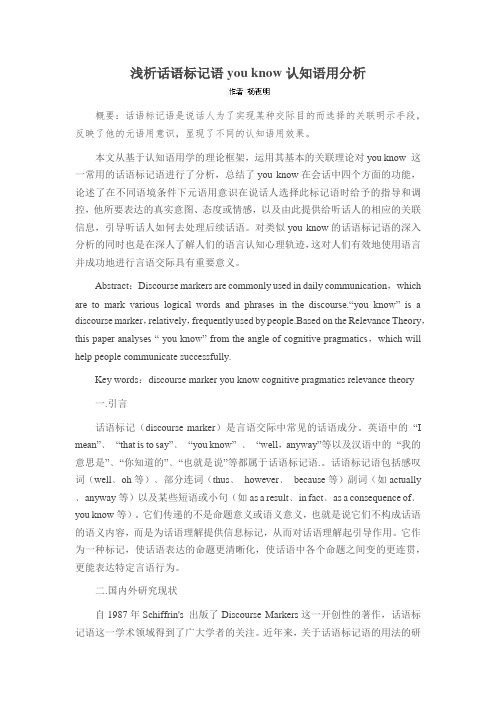
浅析话语标记语you know认知语用分析概要:话语标记语是说话人为了实现某种交际目的而选择的关联明示手段,反映了他的元语用意识,显现了不同的认知语用效果。
本文从基于认知语用学的理论框架,运用其基本的关联理论对you know 这一常用的话语标记语进行了分析,总结了you know在会话中四个方面的功能,论述了在不同语境条件下元语用意识在说话人选择此标记语时给予的指导和调控,他所要表达的真实意图、态度或情感,以及由此提供给听话人的相应的关联信息,引导听话人如何去处理后续话语。
对类似you know的话语标记语的深入分析的同时也是在深人了解人们的语言认知心理轨迹,这对人们有效地使用语言并成功地进行言语交际具有重要意义。
Abstract:Discourse markers are commonly used in daily communication,which are to mark various logical words and phrases in the discourse.“you know” is a discourse marker,relatively,frequently used by people.Based on the Relevance Theory,this paper analyses “ you know” from the angle of cognitive pragmatics,which will help people communicate successfully.Key words:discourse marker you know cognitive pragmatics relevance theory一.引言话语标记(discourse marker)是言语交际中常见的话语成分。
英语中的“I mean”﹑“that is to say”﹑“you know” ﹑“well,anyway”等以及汉语中的“我的意思是”﹑“你知道的”﹑“也就是说”等都属于话语标记语.。
话语标记词Well的特殊叙事语用功能研究
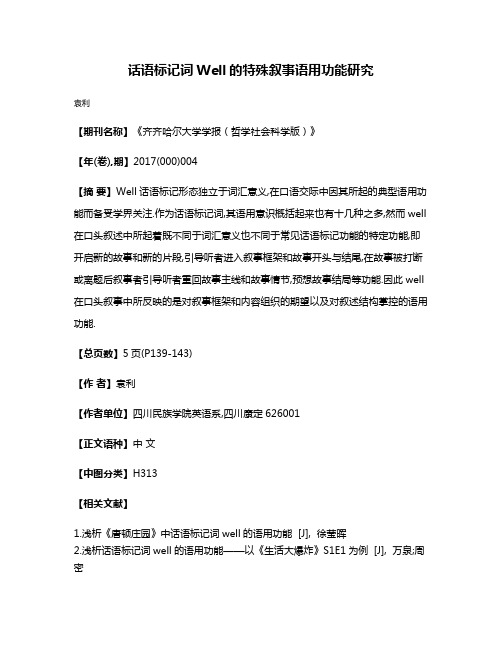
话语标记词Well的特殊叙事语用功能研究
袁利
【期刊名称】《齐齐哈尔大学学报(哲学社会科学版)》
【年(卷),期】2017(000)004
【摘要】Well话语标记形态独立于词汇意义,在口语交际中因其所起的典型语用功能而备受学界关注.作为话语标记词,其语用意识概括起来也有十几种之多,然而well 在口头叙述中所起着既不同于词汇意义也不同于常见话语标记功能的特定功能,即开启新的故事和新的片段,引导听者进入叙事框架和故事开头与结尾,在故事被打断或离题后叙事者引导听者重回故事主线和故事情节,预想故事结局等功能.因此well 在口头叙事中所反映的是对叙事框架和内容组织的期望以及对叙述结构掌控的语用功能.
【总页数】5页(P139-143)
【作者】袁利
【作者单位】四川民族学院英语系,四川康定626001
【正文语种】中文
【中图分类】H313
【相关文献】
1.浅析《唐顿庄园》中话语标记词well的语用功能 [J], 徐莹晖
2.浅析话语标记词well的语用功能——以《生活大爆炸》S1E1为例 [J], 万泉;周密
3.浅析话语标记词well的语用功能——以《生活大爆炸》S1E1为例 [J], 万泉;周密
4.中国英语外语学习者习得口语话语标记词“WELL”语用功能之特征研究——一项基于COLSEC语料库的证据分析 [J], 甄凤超
5.西班牙语中话语标记词 pues 的语用功能研究 [J], 王悦澄
因版权原因,仅展示原文概要,查看原文内容请购买。
试论研究大学英语教师课堂话语标记语的实验构想

试论研究大学英语教师课堂话语标记语的实验构想论文关键词:大学英语课堂话语标记语教师课堂话语实验论文摘要:本文就大学英语教师在课堂上使用话语标记语提出了研究的实验构想,提出将着重对于中国籍大学英语教师在课堂环境下使用的话语标记,基于调查取样进行描述性研究的实验构思,并对实验结果作出推测,为进一步进行实证实验奠定了基础。
话语标记语在语篇的组织中起着连贯上下文、完善交际技巧的作用。
掌握并娴熟地使用话语标记语能够让交流双方达到更加完美的交流程度。
语言教师在给学生授课时更是应注意自己言语的有效力。
目前对于话语标记语在教学方面的研究,国内外的研究焦点多放在学生口语、听力理解、写作的话语标记特点及二语学习者标记和母语学习者标记的对比中,本文的选题新颖之处在于研究对象从学生换成了英语教师,在课堂环境中不同英语专业教师使用话语标记的特点及衔接方式。
该课题对于语言教师如何在课堂环境下有效地使用话语标记语,帮助学生理解课程内容进行了研究。
一、研究背景话语标记的研究对于我们理解交际能力来说至关重要。
话语标记已成为建构功能主义语言模式的语言学家研究的重点。
它们不仅可以使得言谈自然并合乎语境,而且表明语言是人类所独有的。
从20世纪50年代初出现萌芽到70年代中期至80年代中期大量论文论文集的出现,伴随着话语分析、语用学的发展,话语标记的研究亦从中获得了极大的推动。
80年代中后期是话语标记研究的黄金发展阶段。
这段时间无论研究队伍、研究成果,还是在语言学界的影响等,都远胜于前。
1977年,journalofpramatics(《语用学杂志》)在荷兰创刊,现任主编是jacobl.mey(odenseuniversitydenmark)。
1986年该杂志首次以特辑形式介绍各国语言中话语标记研究(当时使用的术语是particle)的概况,本期杂志由澳大利亚国立大学的annawierzbicka编辑,专题以“particles”命名。
论文名称:话语标记语Well语用功能及其在小说《大卫·科波菲尔》中翻译
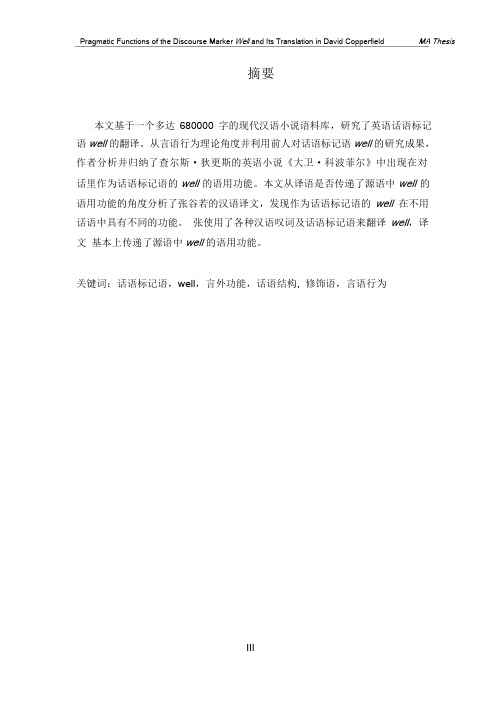
摘要本文基于一个多达680000 字的现代汉语小说语料库,研究了英语话语标记语well 的翻译。
从言语行为理论角度并利用前人对话语标记语well 的研究成果,作者分析并归纳了查尔斯·狄更斯的英语小说《大卫·科波菲尔》中出现在对话里作为话语标记语的well 的语用功能。
本文从译语是否传递了源语中well 的语用功能的角度分析了张谷若的汉语译文,发现作为话语标记语的well 在不用话语中具有不同的功能。
张使用了各种汉语叹词及话语标记语来翻译well,译文基本上传递了源语中well 的语用功能。
关键词:话语标记语,well,言外功能,话语结构, 修饰语,言语行为IIIAbstractThis thesis is a corpus-based research into the Chinese translation of the discourse marker well with a corpus of Chinese novels of modern times with over 680,000 characters. On the basis of the Speech Act theory and a critical review of the previous studies of the marker well, the present study has identified and classified the pragmatic functions of well in the utterances of the English novel David Copperfield by Charles Dickens. The translations of Zhang are analysis to see whether they retain the specific illocutionary function carried by well in the source text. It has been found that the discourse marker well fulfills various illocutionary functions in different utterances in the source text; and, the various Chinese interjections and discourse markers have been adopted in Zhang’s rendering most of which have fully conveyed the same illocutionary function as in the source language.Key words: discourse markers, well, illocutionary function, frame, qualifier, speech actII学位论文原创性声明本人郑重声明:所呈交的学位论文,是本人在导师的指导下,独立进行研究工作所取得的成果。
话语标记词论文:话语标记词well的功能和意义的语用学分析

话语标记词论文:话语标记词well的功能和意义的语用学分析摘要:well作为英语话语标记词的研究越来越吸引研究者的注意。
其用法独特。
well的功能主要包括:作为面子威胁的缓和语、缓延标记语、信息短缺标记语、信息修正标记语。
其功能和意义在很大程度上取决于语境。
本文从语用学的角度分析well作为话语标记语的功能和意义特征。
关键词:话语标记词;语用学;功能;意义一、引言well作为形容词、副词、动词和名词的用法,英语学习者已不陌生。
本文将讨论well作为话语标记词的用法。
以下例句中的well用法将不在本文讨论之列:(1)all the team played very well.(2)the organization gives help and support to people in need, as well as raising money for local charities.(3)i don’t feel very well.(4)most people are not very well-informed about this disease.(5)he dug a well in the field.(6)water wells from a spring in distance.话语标记词, 朗文语言教学与应用语言学词典作出以下解释:“用来连接两段话语但对它们的意思无影响的表达式” (jack, c. r., richard, s., heidi, k., & youngkyu. k.2005: 209)。
笔者认为该定义是否准确,值得商榷。
当然,如果从语义学角度来看,这个定义毫无争议;但若从语用学角度来看,此定义是有不妥之处。
从语用学角度来看,话语标记词隐含了某种言外之意(implicture)。
如:(7)a: do you love your wife?b1: yes.b2: well, yes.如果从语义学上来看,well对于两个回答来看,基本上没有什么意义上的区别。
从语用学看“基础英语”课堂中学生言语交际能力的培养——以话语标记语“well”为例

2022年4月第17期Apr. 2022No.17教育教学论坛EDUCATION AND TEACHING FORUM从语用学看“基础英语”课堂中学生言语交际能力的培养——以话语标记语“well”为例范晨曦(山东第一医科大学〔山东省医学科学院〕 外国语学院,山东 泰安 271000)[摘 要] 充分利用“基础英语”课程教材,以教材中的会话文本为语料,通过分析会话文本,总结会话材料中出现频率最高的话语标记语“well”的主要语用功能,并通过实验和调查相结合的方法,探究学生在学习和使用话语标记语过程中存在的问题、问题产生的原因和解决问题的策略,以期帮助英语学习者建立语境观念,从动态的角度理解会话材料,进而促进其言语交际能力的提高。
[关键词] 基础英语教学;言语交际能力;话语标记语[基金项目] 2018年度泰山医学院教育教学项目“语用学理论应用于高校英语专业基础英语教学实践的探索”(XY2018075);2020年度大学外语教学科研项目“基础英语教学中语言学理论的多模态渗透模式研究”(2020103102)[作者简介] 范晨曦(1985—),女,山东新泰人,文学博士,山东第一医科大学(山东省医学科学院)外国语学院讲师,主要从事英语语言学、认知语义学、语用学研究。
[中图分类号] G642.0 [文献标识码] A [文章编号] 1674-9324(2022)17-0025-04 [收稿日期] 2022-01-16“基础英语”作为一门专业基础必修课程,旨在提高学生的听、说、读、写、译五个方面的综合专业技能;但在多种因素的影响下,“基础英语”课堂教学仍将重点放在了语言形式和意义内容的讲解上,忽视了对学生口语交际能力的培养。
本研究以英语专业“基础英语”课程教材中的会话材料为语料,在话语标记语的已有研究成果基础上[1-5],对学生关于话语标记语“well”的含义及语用功能的理解和使用进行了研究,旨在探究“基础英语”课堂口语教学中学生会话能力培养存在的问题和解决策略,促进英语学习者通过教师对会话材料的显性教学和个人有意识的会话实践逐渐建立语境观念,进而促进其言语交际能力的提高。
学生话语标记语语用意识培养研究[论文]
![学生话语标记语语用意识培养研究[论文]](https://img.taocdn.com/s3/m/3d0d2c8fb9d528ea81c77957.png)
学生话语标记语的语用意识培养研究摘要:研究表明,较之英语本族语使用者,我们的英语学习者话语标记语的使用存在简单化以及固定化现象。
本文在这些研究基础上通过问卷调查来分析探讨该现象的原因,并对大学英语教学中学生的话语标记语的语用意识培养提出建议。
关键词:话语标记语;语用意识;英语教学话语标记语(discourse markers)是话语当中十分常见的用来标记话语信息的词或短语。
但由于国内外学者对于其研究的角度和切入点不同,话语标记语又被称为语义联加语、语句联系语、语用表述语、语用标记语等等。
本文则统称为“话语标记语”。
话语标记语,如well, you know, i think, but, however, and, so,therefore等等,体现的不只是形式上的特点与功能,它们在语用功能及语篇连贯方面起很大的作用。
话语标记语的熟练掌握不仅有助于交际的顺利进行,而且有助于语篇的连贯性。
1目前存在的问题正因为话语标记语在语篇连贯、语用功能等方面的作用,母语使用者对它们的使用频率很高。
但在我们学生的口语表达以及书面表达中,学生或者过度滥用标记语,或者很少使用,即使使用也是较单一固定的。
国外研究者对母语使用者和非母语使用者的话语标记语的使用情况进行研究比较发现非母语使用者在话语标记语的使用上存在一定程度的语用石化现象(fuller,2003;trillo,2002)。
国内不少研究者也对中国学生话语标记语使用情况进行调查,得出中国学生话语标记语使用具有简单化、固定化、僵化等特点(何安平,徐曼菲,2003;王雪玉,2007)。
就比如说but, however这两个对比性话语标记语,我们的英语学习者和英语母语使用者的偏好不一样。
我们的英语学习者更喜欢使用but这个最常见的对比性话语标记语,虽然也使用however,但较之母语使用者,其使用频率相对较低。
however在话语中的位置比较灵活,可以置于话轮前,或话轮中,或话轮末。
话语标记语“you know”的语用功能及汉语翻译
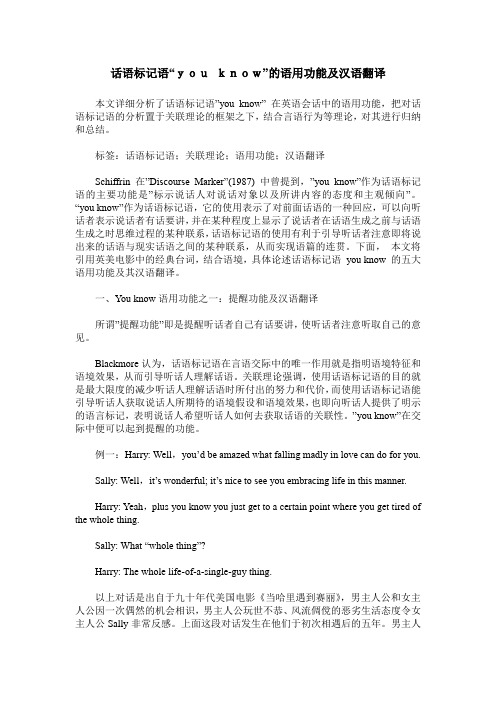
话语标记语“youknow”的语用功能及汉语翻译本文详细分析了话语标记语”you know” 在英语会话中的语用功能,把对话语标记语的分析置于关联理论的框架之下,结合言语行为等理论,对其进行归纳和总结。
标签:话语标记语;关联理论;语用功能;汉语翻译Schiffrin 在”Discourse Marker”(1987) 中曾提到,”you know”作为话语标记语的主要功能是”标示说话人对说话对象以及所讲内容的态度和主观倾向”。
“you know”作为话语标记语,它的使用表示了对前面话语的一种回应,可以向听话者表示说话者有话要讲,并在某种程度上显示了说话者在话语生成之前与话语生成之时思维过程的某种联系,话语标记语的使用有利于引导听话者注意即将说出来的话语与现实话语之间的某种联系,从而实现语篇的连贯。
下面,本文将引用英美电影中的经典台词,结合语境,具体论述话语标记语you know 的五大语用功能及其汉语翻译。
一、You know语用功能之一:提醒功能及汉语翻译所谓”提醒功能”即是提醒听话者自己有话要讲,使听话者注意听取自己的意见。
Blackmore认为,话语标记语在言语交际中的唯一作用就是指明语境特征和语境效果,从而引导听话人理解话语。
关联理论强调,使用话语标记语的目的就是最大限度的减少听话人理解话语时所付出的努力和代价,而使用话语标记语能引导听话人获取说话人所期待的语境假设和语境效果,也即向听话人提供了明示的语言标记,表明说话人希望听话人如何去获取话语的关联性。
”you know”在交际中便可以起到提醒的功能。
例一:Harry: Well,you’d be amazed what falling madly in love can do for you.Sally: Well,it’s wonderful; it’s nice to see you embracing life in this manner.Harry: Yeah,plus you know you just get to a certain point where you get tired of the whole thing.Sally: What “whole thing”?Harry: The whole life-of-a-single-guy thing.以上对话是出自于九十年代美国电影《当哈里遇到赛丽》,男主人公和女主人公因一次偶然的机会相识,男主人公玩世不恭、风流倜傥的恶劣生活态度令女主人公Sally非常反感。
话语标记“你知道”

话语标记“你知道”一、本文概述本文旨在探讨和分析话语标记“大家知道”在日常交流中的使用及其功能。
话语标记是一种语言中常见的语言现象,它们并不直接传递信息,而是用来引导、组织或标记话语的各个方面。
在中文语境中,“大家知道”作为一种常见的话语标记,具有丰富的语用功能和社交意义。
文章将首先对话语标记“大家知道”的基本定义和性质进行阐述,明确其在语言学中的定位。
接着,通过对大量语料的分析,本文将探讨“大家知道”在不同语境下的使用情况和功能,如提示信息、引导对话、表达情感等。
文章还将讨论“大家知道”在跨文化交流中的使用及其可能带来的影响。
通过本文的研究,我们期望能够更深入地理解话语标记“大家知道”在中文交流中的重要作用,以及它在不同语境和社交环境中的灵活应用。
本文也旨在为语言学研究和语言教学提供有价值的参考和启示。
二、话语标记概述话语标记(discourse markers)是自然语言中的一种特殊语言现象,它们在句子中并不承担主要的命题内容,但却在交流中起到了至关重要的作用。
这些标记语通过提供语境信息、标明说话者的态度或情感、帮助听者理解话语结构等方式,增强了语言交流的有效性和连贯性。
话语标记的存在使得对话者能够更好地理解对方的意图,从而进行更加顺畅的交流。
“大家知道”作为一种常见的话语标记,在日常对话中频繁出现。
它通常出现在句子的开头或中间,用于引导一个信息点或是对某个信息的进一步阐述。
通过使用“大家知道”,说话者可以暗示听话者接下来所提供的信息可能是已知的,或者是值得注意和关注的。
这种话语标记不仅能够吸引听话者的注意力,还能帮助说话者构建更加清晰、有条理的话语结构。
对话语标记的深入研究有助于我们更好地理解语言交际中的动态过程,揭示语言使用者在交流中所采取的策略和技巧。
对于话语标记的研究也有助于提高自然语言处理技术的性能,为机器翻译、语音识别、对话生成等应用提供更为准确的语境信息和语义理解。
因此,对话语标记“大家知道”的研究不仅具有理论意义,还具有广泛的应用价值。
2021年英语口语话语标记语习得研究论文

英语口语话语标记语习得研究论文话语标记语的使用并不是为了表达任何意义或者意思,它的作用是为理解谈话的意思提供一些信息标记。
话语标记语的作用是 ___语篇功能、人际谈论功能和元语言功能。
中国学生的话语标记语的使用明显低于以英语为母语的学生,中国学生在使用标记语时,常出现错误使用、胡乱使用的问题。
为了解决这些问题,教师在教学中要引导学生理解话语标记语,让学生勇敢地尝试利用话语标记语去和同伴交流,不断扩展和延伸话语标记语的使用方向和范围,帮助学生提高英语口语表达能力。
中国学生;英语口语;话语标记语(一)语用标记语的概念我国著名的学者冉永平在他的文章中写道:“语用标记语的使用并不是为了表达任何意义或者意思,它的作用只是为了方便理解谈话的意思提供一些信息标记而已。
”[1]这里的语用标记语即话语标记语。
(二)话语标记语的作用话语标记语的首要作用是为了交流。
虽然各学者的表述不同,但是综合各位学者的观点,话语标记语的作用可以概括为以下三个方面:第一, ___语篇功能,即话语标记语能够用来作为 ___语言的一部分内容、构建人际交流所需要的语境,使得谈论的话语意义更加连贯、有条理;第二,人际谈论功能,即人际功能,说话人可以借助和利用标记语来引起倾听者的注意力,使话语正常进行,可以协调说话人和听话人之间的关系;第三,元语言功能,简言之,标记语能够表明说话人当时的感情与态度。
(三)话语标记语习得研究现状目前国内学者和教育家开始对话语标记语产生兴趣,并且开始研究话语标记语的作用,其中以下学者的观点比较有代表性。
何安平和徐曼菲两人在xx年共同研究了我国大学生在口语表达时小品词的使用情况。
经过研究有以下几点新的发现:第一,无论是从数量上还是从使用频率上来说,中国学生的小品词的使用都明显低于以英语为母语的学生;第二,即使是相对简单的“二字语”小品词,比如Isee、Imean、Ithink等,其使用频率与以英语为母语者相比也仍存在较大的距离,特别是形式上的多样性和前后使用富有变化性这一方面。
英语专业学生习得话语标记语WELL语用功能之实证研究_李民
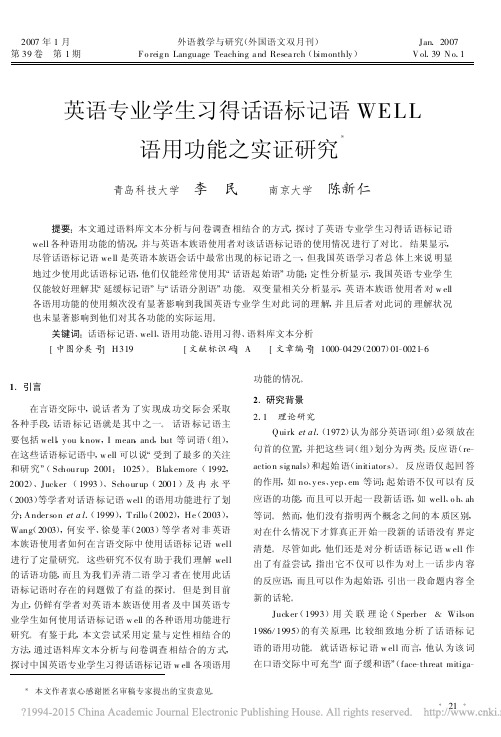
李 民 陈新仁 英语专业学生习得话语标记语 W ELL 语用功能之实证研究
中国英语学习者总体上在写作中有 意识地使 用话语标 记语来提示内容之 间的 关系 , 但这 种使 用有 比较 明显 的个体差异 : 有的 人要 么不 用 , 要么 几乎 每句 话都 用 。 基于对国 际 英语 学 习者 口 语 语料 库 ( L IN DSEI) 的分 析, H e ( 2003) 指出 well 虽然是 英语本族 语使用 者最常 用的话语标记语 , 但中国英语 学习者却 很少使用 ; 何安 平 、徐曼菲( 2003 : 451) 进一步指出 , 对 well 等 话语标记 语的使用“ 可能 成为 区别学 生口 语流利 性发 展过 程的 阶段性表征之一” 。 通 过分析 中国 学习 者口 语语 料库 ( SECC L) , Wang( 2003) 指出 , 中 国英 语学 习者 同 英语 本族语使用者相比 总体 上来 说较少 使用 话语 标记 语 , 但是倾向于过多使用 and , but , I think 等标记语 。 不难看出 , 目前 很少 有研 究分 析中 国英 语学 习者 习得话语标记语 w ell 语 用功能 的情 况 。 有鉴 于此 , 本 文将采用定量和定 性分 析相 结合的 方法 , 从 理解 和产 出两个方面 , 通过与英语本族 语使用者 的对比 , 来探讨 中国英语专业学生习得此话语标记 语的各项 语用功能 的状况 。 3 .研究方法 3. 1 研究问题 本研究拟回答以下五个问题 : ( 1) 英语本族 语者在 口语交际中如 何使 用话 语 标记 语 well 的 各种 语 用功 能?( 2) 中国英 语专业 学生 能在 多大 程度 上理 解 well 的这些功能 ? ( 3) 中国 英语 专业学 生在 口语 中如 何使 用 well 的这些功能 ? ( 4) 英语 本族语 者使用 well 功能 的情况如何影响中 国英 语专 业学生 理解 这些 功能 , 以 及中国英语专业学生对 we ll 功能的理解情况如何影响 他们在口语交际 中对 其功能 的使 用 ? ( 5) 英 语本 族语 者与中国英语专业学生在 we ll 语用功能的使用上有何 差异 ? 3. 2 研究材料 本研究采用语料 库文 本分 析的 方法 , 其 中英 语本 族语口语语 料库为 T he Santa Barbara Co rpus of Spoken Ame rican Eng lish( SBCSA E) ( Par t I); 为了便 于研 究 , 笔者首先将每行起始位置 的时间信 息手工删除 , 然 后再进行相关 数 据 统计 , 数据 显 示 , 该 语料 库 共包 含 72736 个词次 。 所使用的 中国学 习者 英语 口语语 料库 为 T he Spoken Eng lish Cor pus of Chinese Learner s ( SECC L) , 该语料库 是南 京大学 创建 的中国 英语 专业 学生二年级口语 语料 库 。 该语 料库包 括三 部分 ( 故事 复述 、即席讲话 和对话), 本研 究仅 采用 其中 的第 三部 分 , 即对话部分 。 由于笔 者需 要对 所选 文本 中的 话语 标记语 well 进行逐一功能划分并做标记 , 工作量巨 大 ,
基于构式语法的英语话语标记语youknow的研究

基于构式语法的英语话语标记语youknow的研究【摘要】话语标记语you know是言语交际中常见的话语表达形式,有多种语用功能。
构式语法自提出以来便引起了国内外学者的广泛关注,本文以构式语法理论为基础,尝试将you know作为一个构式来研究,分析其形式、意义和功能,以进一步推动使用构式语法分析研究话语标记语。
【关键词】构式语法;话语标记语;You know1 话语标记语话语标记语(discourse markers)是言语交际中说话者为使听话者更好地理解语句之间以及交际情景中各种因素之间的连贯关系,从而实现成功言语交际所采用的重要手段之一,从结构上看这些表达方式不仅限于单词,还包括短语或结构组合,它们体现的不只是形式上的特点与功能,应该被视为话语信息的一部分,其作用不是局部的,主要是从整体上对话语的构建与理解产生影响,具有动态的语用特征。
日常言语会话中存在很多类似you know、you see、see,say,listen,oh、I mean、that is to say、in the other words、well、however等常见的言语表达形式,这些话语标记语近似于汉语中的“你知道”、“我的意思是”、“我想说的是”等插入语,其中you know是一个使用频率颇高而且语用功能十分丰富的话语标记语。
2 话语标记语“you know”“You know”是20世纪80年代以后最早对话语标记语进行研究的学者之一Ostman研究的第一个话语标记语。
Ostman认为此话语标记语可以帮助听话者理解说话者所隐含传递的各种态度和情感及与语境有关的必要信息。
作为一个常用的话语标记语,“you know”大致有四种语用功能:第一,信息提醒功能“you know”的信息提醒功能指的是言语交际中的说话人通过使用you know 这个话语标记语,突显其与听话人彼此之间共享的信息。
例1:A:Can you help me with my forthcoming interview?It is said you have much experience.B:No problem. You should make a good impression on the interveners,you know,your qualities are very important,including your physical appearance,energy,rate of speech,pitch and tone of voice,gestures,expression through the eyes. Others form an impression about you based on these.此例中,you know 显然是提醒对方应该知道的常识性信息。
语用等效视角下话语标记语You Know的字幕翻译研究
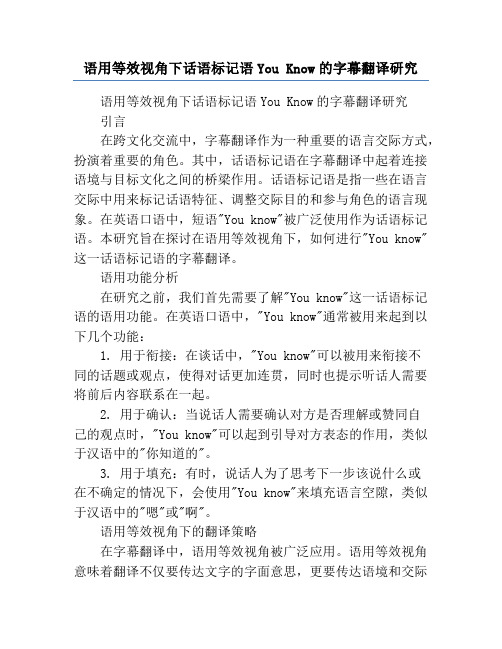
语用等效视角下话语标记语You Know的字幕翻译研究语用等效视角下话语标记语You Know的字幕翻译研究引言在跨文化交流中,字幕翻译作为一种重要的语言交际方式,扮演着重要的角色。
其中,话语标记语在字幕翻译中起着连接语境与目标文化之间的桥梁作用。
话语标记语是指一些在语言交际中用来标记话语特征、调整交际目的和参与角色的语言现象。
在英语口语中,短语"You know"被广泛使用作为话语标记语。
本研究旨在探讨在语用等效视角下,如何进行"You know"这一话语标记语的字幕翻译。
语用功能分析在研究之前,我们首先需要了解"You know"这一话语标记语的语用功能。
在英语口语中,"You know"通常被用来起到以下几个功能:1. 用于衔接:在谈话中,"You know"可以被用来衔接不同的话题或观点,使得对话更加连贯,同时也提示听话人需要将前后内容联系在一起。
2. 用于确认:当说话人需要确认对方是否理解或赞同自己的观点时,"You know"可以起到引导对方表态的作用,类似于汉语中的"你知道的"。
3. 用于填充:有时,说话人为了思考下一步该说什么或在不确定的情况下,会使用"You know"来填充语言空隙,类似于汉语中的"嗯"或"啊"。
语用等效视角下的翻译策略在字幕翻译中,语用等效视角被广泛应用。
语用等效视角意味着翻译不仅要传达文字的字面意思,更要传达语境和交际意义。
在翻译"You know"这一话语标记语时,我们需要根据语用功能选择合适的翻译策略。
1. 衔接功能:针对"You know"作为衔接的功能,可以选择使用类似的话语标记语或连接词来传达衔接的意思。
比如,在字幕中可以翻译成类似于"而且"、"而且还有"等连词,以表达话题之间的连贯性。
话语标记英文作文

话语标记英文作文下载温馨提示:该文档是我店铺精心编制而成,希望大家下载以后,能够帮助大家解决实际的问题。
文档下载后可定制随意修改,请根据实际需要进行相应的调整和使用,谢谢!并且,本店铺为大家提供各种各样类型的实用资料,如教育随笔、日记赏析、句子摘抄、古诗大全、经典美文、话题作文、工作总结、词语解析、文案摘录、其他资料等等,如想了解不同资料格式和写法,敬请关注!Download tips: This document is carefully compiled by theeditor. I hope that after you download them,they can help yousolve practical problems. The document can be customized andmodified after downloading,please adjust and use it according toactual needs, thank you!In addition, our shop provides you with various types ofpractical materials,such as educational essays, diaryappreciation,sentence excerpts,ancient poems,classic articles,topic composition,work summary,word parsing,copyexcerpts,other materials and so on,want to know different data formats andwriting methods,please pay attention!Oh, that was a great day. I went to the park and saw so many beautiful flowers. It was amazing.Well, I don't really like that movie. It's kind of boring.You know, I had a really interesting conversation with my friend yesterday. We talked about all kinds of things.Actually, I think I'm going to take a break and have a cup of coffee.Wow, look at that rainbow! It's so colorful.Anyway, I need to finish my homework before I can do anything else.。
- 1、下载文档前请自行甄别文档内容的完整性,平台不提供额外的编辑、内容补充、找答案等附加服务。
- 2、"仅部分预览"的文档,不可在线预览部分如存在完整性等问题,可反馈申请退款(可完整预览的文档不适用该条件!)。
- 3、如文档侵犯您的权益,请联系客服反馈,我们会尽快为您处理(人工客服工作时间:9:00-18:30)。
话语标记语论文:话语标记语 well so like及you knou 中国英语专业研究生语境语用功能
【中文摘要】研究表明,话语标记语在语言交流中扮演着重要的角色。
因此,它们已成为语言学领域学者们所追捧的研究对象。
本文首先回顾了话语标记语研究中一些最常见的概念与构念,如话语标记语的术语名称,显著特征,语用功能及其分类。
文章重点分析了四个常用的话语标记语,即well, so, like和you know,并分别介绍了它们的语用功能及英语学习者的习得情况。
基于前人的研究,本论文提出了五个假设,对不同英语水平的中国英语专业研究生习得话语标记语的情况作出了预测。
研究结果表明中国英语专业研究生,尤其是低水平组的受试,他们和中国的中学生及本科大学生一样,仍然需要提高
在英语口语中恰当使用话语标记语的能力。
文章主要从三个方面揭示他们使用well, so, like和you know时的不当之处,其中包括在不同语境中话语标记语的使用频率,话语标记语类型以及语用功能。
【英文摘要】It has been suggested that DMs (discourse markers) play a very important role in the language communication, and therefore they have become a popular research object in the linguistic area.This paper first reviews some general aspects concerning DMs, such as their confusing terminology, common properties, complex functions and
classification. What’s more, the paper especially focuses on four frequently-used oral DMs, i.e., well, so, like and you know, as well as their pragmatic functions. L2 acquisition...
【关键词】话语标记语 well so like及you knou 中国英语专
业研究生语境语用功能
【采买全文】1.3.9.9.38.8.4.8 1.3.8.1.13.7.2.1
同时提供论文写作定制和论文发表服务.保过包发.
【说明】本文仅为中国学术文献总库合作提供,无涉版权。
作者如有异议请与总库或学校联系。
【英文关键词】discourse markers well so like and you know Chinese English-major postgraduates speech contexts pragmatic functions
【目录】中国英语专业研究生活话语标记语Well,So,Like,You Know的习得研究摘要2-3Abstract3中文文摘
4-6Contents6-8Chapter One Introduction8-12 1.1 Discourse Makers:the Target of Research8-9 1.2 Rationale for the Study9-10 1.3 Organization of the
Thesis10-12Chapter Two Literature Review12-28 2.1 Discourse Markers12-15 2.2 Pragmatic Functions of
Well,Like,So,You Know15-21 2.3. L2 Acquisition of
Well,Like,So,You Know21-28Chapter Three Research Hypotheses and the Empirical Study28-36 3.1 Research
Hypotheses28-29 3.2 The Empirical Study29-36Chapter Four Results for Research Hypotheses Testing and General Discussion36-48 4.1 Results for Hypothesis 136-37 4.2 Results for Hypothesis 237-39 4.3 Results for Hypothesis 339-41 4.4 Results for Hypothesis 441-43 4.5 Results for Hypothesis 543-48Chapter Five Conclusion48-52 5.1 Summary of Research Findings48-49 5.2 Pedagogical Implication49-50 5.3 Limitations and Suggestions for Further Research50-52References52-54Appendix 1 Sample Test54-55Appendix 2 Demographic Questionnaire55-56攻读学位期间承担的科研任务与主要成果
56-58Acknowledgments58-60个人简历60-62。
